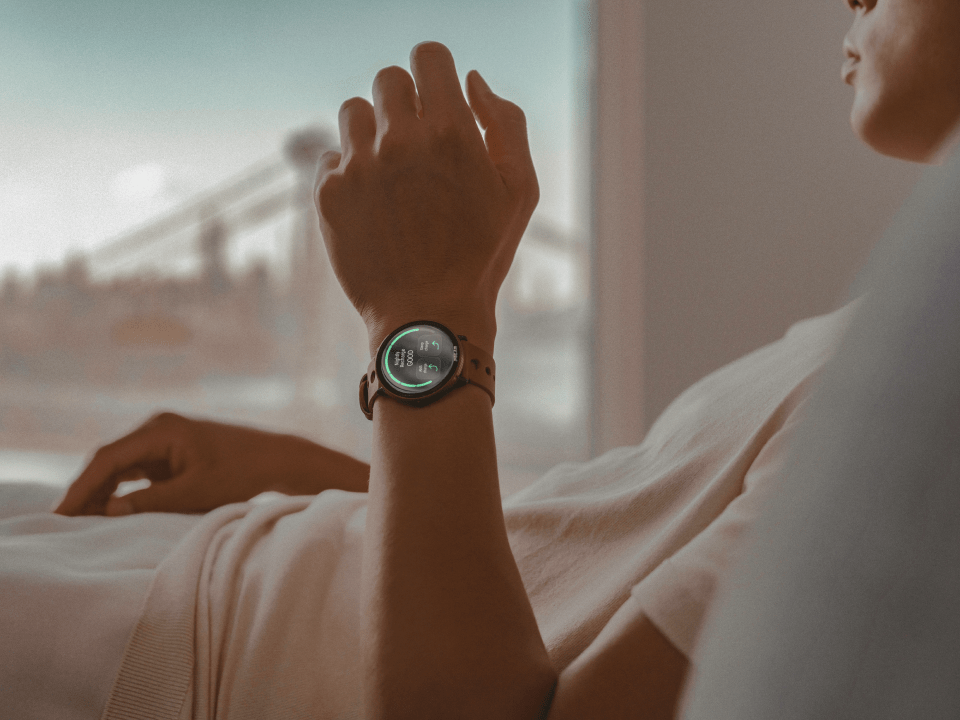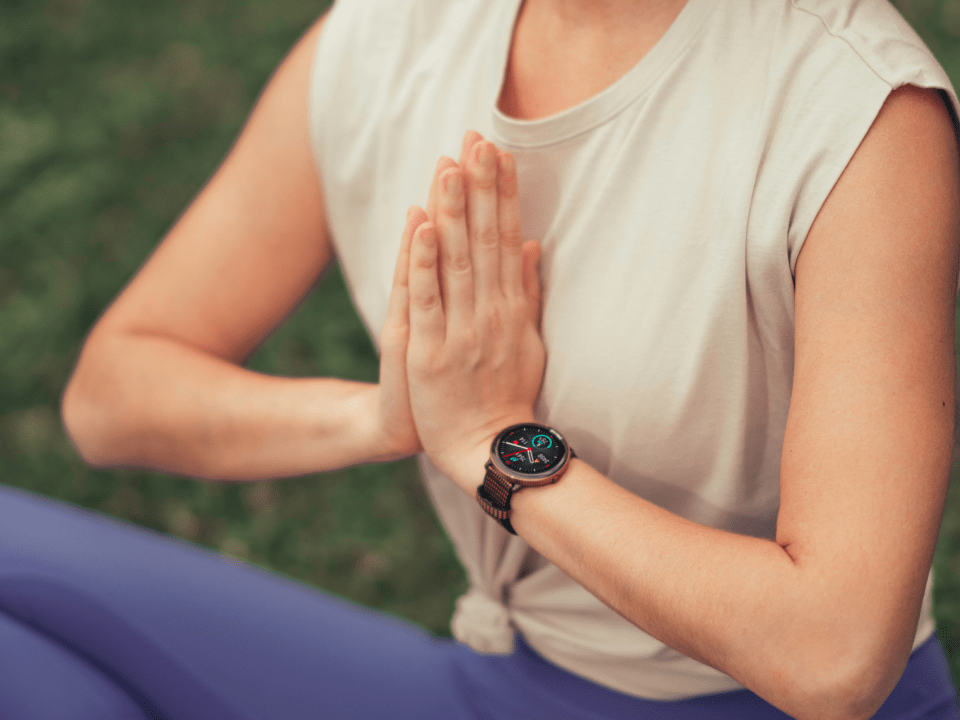You know when a cartoon character is stressed: they’re gripping their hair, their face looks panicked or furious, and maybe steam is coming out of their ears. But can you easily recognize when you are stressed? Or can technology help you identify and begin managing your stress before you start behaving like a cartoon yourself?
Understanding what stress is and how it shows up in your life is an essential first step in learning how to cope with it. For example, exercise temporarily places stress on your body, but it’s also one of the most effective ways of managing stress. Similarly, the ubiquity of technology means it’s easy to be ‘always on’ and miss out on essential downtime from work. However, when used in the right way, technology can also be an excellent tool for reducing the effects of stress.
We look at some of the great ways that combining wearable technology and mobile devices with good sleep, nutrition, and exercise, plus tools like meditation and yoga, can help manage stress.
What is stress?
Stress is a response to a situation where a person feels they don’t currently have the necessary resources to deal with challenges and demands in their life.
It’s important to note that no one thing will cause everyone to experience stress in the same way. Stress depends on an individual’s resistance and tolerance, especially their perspectives and attitudes. As the Greek philosopher Epictetus said, “It is not things themselves that trouble us, but our perception of them.”
You can experience stress in a variety of ways, depending on your stress response. Rapid heartbeat, trembling, dry mouth, and sweating palms are just some of the common reactions you can have when you suddenly begin to feel stressed.
How does your stress response occur?
When you encounter a situation you think may be dangerous, your eyes and/or ears fire off a quick message to your amygdala in your brain. It’s the center responsible for your emotional behavior and motivation, so the amygdala assesses if you’re in a bad situation and then alerts the hypothalamus if there’s a reason for concern, like a distress signal. All of this happens in less than a second before you’ve even cognitively processed what is happening.
The hypothalamus is a small but crucial gland in your brain that acts as your control center. Its main role is to keep your body in a stable state (known as homeostasis) and it does this mainly by communicating with the rest of your body through the autonomic nervous system (ANS). There are two branches of your ANS that are key to regulating your stress response:
- Your sympathetic nervous system (SNS) triggers your ‘fight or flight’ stress response, providing the body with a burst of energy so that it can respond to perceived dangers.
- Your parasympathetic nervous system (PSNS) activates your ‘rest and digest’ response when you feel the danger has passed so that your body can return to calm.
It’s your hypothalamus that alerts your SNS, pumping adrenaline, glucose, and fats into your bloodstream to give you this energy. Your heart rate and blood pressure also increase, as does your capacity to breathe more oxygen. What this does is enable your body to suddenly be more alert and aware, sharpening your senses in case you are indeed in danger. This is why you’re able to quickly stop or swerve without thinking when you’re running, cycling, or driving and an unexpected obstacle pops up.
Chronic stress and your HPA axis
Once that first surge of adrenaline wears off, your hypothalamus activates the second phase of your stress response. Here your hypothalamus works with your pituitary gland and adrenal glands to monitor through a series of hormonal signals if it should keep your SNS activated and your body on high alert. This network is known as your HPA axis.
If your HPA axis doesn’t think there is any continued reason for concern, it will let your PSNS take over, calming your body down and dissolving this stress response. However, if your HPA axis continues to stay alert, your adrenal glands will release cortisol, your primary stress hormone, which is effectively like keeping your engine revved up.
Chronic low-level stress will keep your HPA axis activated and cortisol levels flowing, which isn’t good news for your physical or mental health. If this happens, you will start to experience a variety of symptoms which not only can help you realize you’re stressed but could also contribute to some major health problems long-term.

Symptoms of stress
As we have seen above, the body indicates when it is experiencing stress. A wide variety of symptoms show up in a range of physical, mental, and behavioral ways to help us alert us to the need to manage and reduce the stressors in our daily lives.
If left unchecked, chronic stress can take a huge toll on your body. So it’s important to be aware of how it is affecting you and learn to use the available tools and techniques that are available for managing stress.
Behavioral symptoms of stress:
- Social withdrawal
- Over or under eating
- Exercising less
- Increased consumption of tobacco, alcohol, and/or drugs
Physical symptoms of stress:
- Headache
- Fatigue
- Chest pains
- Muscle tension
- Upset stomach
- Sleep issues
- Skin conditions (acne, eczema, and accelerated signs of aging)
Mental health symptoms of stress:
- Lack of motivation
- Feeling overwhelmed
- Pessimism
- Anger and hostility
- Anxiety
- Depression
It’s important to note that dynamic levels of the above mental health symptoms appear to increase the risk of developing heart disease and several other illnesses.
What causes stress?
So much of our everyday lives feel stressful. From our finances, work, and relationships to our age, sleep, and training, there are many key causes of stress.
As mentioned above, no one thing is guaranteed to cause you stress. It all comes down to your approach to life and your capacity to deal with what it sends your way. So, here are some of the most common causes of stress and how they show up in our lives.
Life:
- Day-to-day chores and decisions
- Pressure at work or in home life
- Major life transitions
- Uncertainty and the feeling of losing control of everything are one of the most significant stress-inducing factors.
Age:
- As we age, our brain loses its ability to regulate stress hormone levels, meaning chronic stress can be more severe over fifty. That means a healthy diet and regular exercise, plus some of the other techniques listed below, become even more important in later life.
- Signs of perimenopause (such as anxiety, low energy, depression, and trouble sleeping) can be dismissed as life stress. At the same time, stress can exacerbate the symptoms of perimenopause.
Sleep:
- Inadequate sleep can cause us to struggle with making good choices and feeling motivated, which can create stressful situations in our daily lives.
- Poor sleep also places stress on our bodies. This occurs due to inefficient recovery of the ANS, lower heart rate variability during sleep, a higher resting heart rate, and reduced production of muscle-building growth hormone.
- Not sleeping well can decrease your mood and increase levels of cortisol.
Training and stress
As we’ve mentioned above, regular exercise is a great way to help alleviate the effects of stress. However, intense training is different. It places an enormous amount of stress on your body, which isn’t able to differentiate between forms of stress. So, whether it’s your work, relationships, or training that’s the cause, your body will process all forms of stress in the same way.
It can be tempting to train harder as a way of managing stress when life gets a little hectic – but that will only add to the problem rather than solve it. So, what you expect to be a stress reliever will probably make you more fatigued and irritable or cause your mental health to deteriorate.
It’s important to learn what’s the optimal amount of training for your body (not too little, not too much) and think about how to handle the additional stress when you go over this, such as when you run a marathon. It’s also important to remember that when you are returning to training after a break or an injury, you should pace yourself and not set unreasonable expectations.
WHY TECHNOLOGY IS EXCELLENT FOR MANAGING STRESS
Not knowing how to cope with stress can often make us feel even more powerless in facing the challenges that drain us. So, it’s important to remember that managing stress is all about identifying the issues in different areas of our life that are causing or contributing to our stress.
Technology is particularly useful for helping us work out what’s going on with our bodies, whether recognizing where we can help bring calm to our lives or even simply acknowledging that we are stressed in the first place. Tools like 24/7 activity tracking and sleep analysis technology can provide insights into how your nervous system works and how you can focus on rebalancing it.
Polar Nightly Recharge™ is an overnight recovery measurement that shows how well your body has coped overall with the stress you have experienced lately. Your body is unable to differentiate between the various sources of stress, such as training strain or pressure at work, and your reactions to stress are highly individual. However, sleep and stress are closely linked and in many people, stress will disturb the quality of their nightly rest. So, it is possible to use your sleep as a barometer for understanding and managing stress.
That’s why Nightly Recharge™ measures two separate metrics for your sleep: your ANS charge and your sleep charge. One looks at the way your nervous system recovered overnight and the other looks at the quantity of sleep you had and how that broke down into sleep stages.
The reason for this is that both indicate how well-rested you are but your ANS charge will specifically show how stress has affected your sleep. For example, it’s quite common that a high-intensity workout causes a decrease in your ANS charge but not in your sleep charge. So, these two areas are measured separately so that every morning you can see how stress may have affected your sleep.
That’s the key thing to remember here: technology can give you the tools for measurement and guidance, but it’s up to you to implement those suggested changes. So, if you’re serious about minimizing the stress in your life, technology is at hand.

Techniques and tools for managing stress
When you’re feeling stressed, it can be hard to know where to focus your energy. That’s why it’s important to understand how you can activate your relaxation response, especially when you are experiencing frequent or chronic stress and want to regulate the way you react to it.
There are a wide variety of tools and techniques for restoring balance to your nervous system. Instead of being reactive to your stress response and only using them when your cortisol levels rise, it’s even better to be proactive about your stress. Incorporating a variety of these tools and practices into your everyday life will not only diminish the amount of stress in your life but also enhance your capacity to deal with it.
Focus on your breath
Diaphragmatic breathing, abdominal breathing, belly breathing – call it what you like but learning how to stop and breathe deeply is one of the most effective tools for managing stress.
The Polar Serene™ breathing exercise is a great place to start if you’ve never done any form of breathwork before. You can do this anywhere, on a bus or in the park on your lunch break. Use your watch to help you focus on your breath for a few minutes to quiet the mind.
Meditation
Meditation is a great way to regularly focus on clearing your mind, helping to prevent you from being flooded with thoughts during overwhelming and stressful situations. It’s a powerful tool for helping to minimize the way you react to stressors. A regular meditation practice will help to shrink your amygdala and increase the size of your frontal lobe (the area of the brain associated with decision-making and emotion regulation).
A 10-minute meditation track is an excellent tool for tuning out your stressful thoughts and tuning in with your body for a set amount of time. Find a comfy spot, focus on your breath, and every time a worry comes to mind, observe it, then return your attention to your breathing.

Mindfulness
Being mindful is about being completely present in the moment rather than allowing your stressed mind to shift your focus elsewhere. Practicing mindfulness can reduce stress and blood pressure and improve your self-awareness and sleep.
Observing what is around you is a simple way to bring your mind back into the present. Simply say (in your mind or aloud) what you can see around you. From furniture to people, cars, buildings, and natural elements, this technique is a fast way to practice mindfulness when you feel your mind beginning to spiral with stress.
Another way to practice mindfulness is while you are running. Focus on quieting your thoughts and shift your attention to where you are and what is happening around you. You can also focus on your body, ensuring your shoulders are relaxed and maintaining a good posture.
Yoga, tai chi, and qigong
A regular practice of any of these ancient arts can work as therapy for both body and mind while boosting recovery from overall stress and improving holistic well-being.
Yoga and tai chi are great ways for endurance athletes to improve their strength, balance, coordination, body awareness, and flexibility all at the same time. These meditative forms of exercise can help to calm your nervous system and center the mind.
Why not make the time for thirty minutes of yoga for stress relief in your day? You’ll quickly be reaping the benefits.
Tracking your recovery
Unsure how well your body has recovered? As we mentioned above, Polar Nightly Recharge™ can tell you. By measuring your ANS activity, you can see if your body has been able to recover from training and stress by giving tips on exercise, sleep, and regulating your energy levels.
This is a great tool for teaching you how to improve night-time recovery by paying attention to what occurs the day before. Have a drink in the evening after a stressful day at work? Take note of how your ANS Charge is the following day. Finding yourself feeling anxious and worried about the week ahead? See how your ANS is or isn’t able to rest and recover at night by paying attention to this metric as well.
Increasing the quality of your sleep
Sleep has an enormous impact on how we feel in our everyday lives. Good quality sleep can enhance how you eat, train, view yourself, and interact with others. Regular poor-quality sleep can decrease your focus, motivation, and problem-solving abilities, diminish your memory and learning capacities and inhibit your stress regulation.
Other factors, such as alcohol, the food you eat in the evening, the screen light on your devices, and the air quality in your bedroom, can also affect your sleep. So, it’s essential to have good sleep hygiene to ensure you sleep better every night.
Here are some key ways to enhance your sleep:
- Reduce long daytime naps as they can impair your sleep quality.
- Align your sleep time to your circadian rhythm.
- Reduce light exposure, caffeine, and alcohol consumption late in the evening.
- Optimize your bedroom’s environment by keeping it cool, dark, quiet, and relaxing.
- Minimize your electronic use in the bedroom.
- Try a meditation session before heading off to bed.
- Create the right sleep environment and/or use a weighted blanket (the pressure can help activate your PSNS).
A great tool for creating an optimal sleep schedule is Polar SleepWise™. By tracking your sleep-wake cycle, this Smart Coaching feature will be able to tell you when you will be most alert during the day and even recommend the ideal sleep time for you in the evenings. It’s small changes through technology like this that help you sleep better and manage stress more effectively.
Nutrition
Eating well promotes improved sleep and energy levels, supports healthy hormones, and enhances your mood and mental state. All of these factors will boost your ability to deal with stressors in your everyday life, so it’s always important to focus on good nutrition.
It’s vital to focus on how you fuel your body for training. Staying hydrated is essential, especially for preventing cramping and flushing toxins from your body. Magnesium is an excellent nutrient for relieving muscle soreness and reducing inflammation. After a workout, aim to get 20-30g of high-quality protein with a source of simple carbohydrates, and if you’ve just completed a race, then definitely reward yourself with a good meal.
Exercise
Finding enjoyable ways to move your body is an excellent tool for managing stress. Exercise will not only help to regulate your ANS but will improve your mood and enhance your memory and concentration.
Spending time outdoors, especially in green areas, is very effective at relieving stress. Go for a leisurely walk or an endorphin-lifting run to boost the feel-good chemicals in your brain.
Social support
Spending time with loved ones is a great way to manage stress. Go for a walk with a friend, enjoy playtime with your children, or make time in your busy calendar to go for a date night with your partner.
The primary factor contributing to resilience is having caring and supportive relationships, both within and outside your family. So, no matter what you do, connecting with others and talking about what you are going through will help you to feel stronger.
Conclusions: managing stress with technology
From tracking your rest and recovery to breathing exercises and meditation tracks, there are various ways that technology can assist with alleviating stress.
So how can you begin incorporating all of this information into your daily life?
- Start by paying attention to your body. When do symptoms occur for you?
- Use technology to track your heart rate and sleep. Can you see how your metrics are affected when you are stressed?
- Find a tool, like yoga or mindfulness practice, that you can use either every day or when you are experiencing stress.
Remember, as the Persian proverb says, “this too shall pass,” so utilize the technology and techniques for a calmer, happier tomorrow.
If you liked this post, don’t forget to share so that others can find it, too.
Or give it a thumbs up!
I like this article
Please note that the information provided in the Polar Blog articles cannot replace individual advice from health professionals. Please consult your physician before starting a new fitness program.





